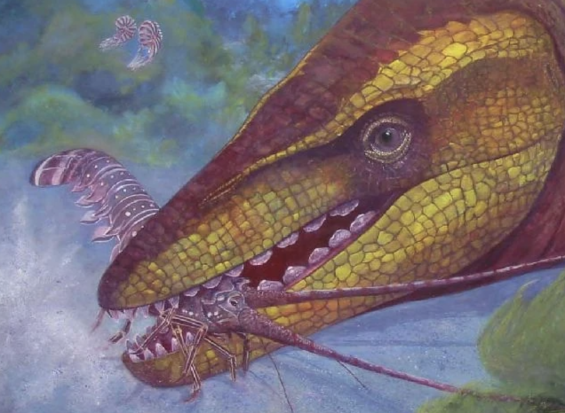An ancient genus of Cretaceous mosasaurs, an extinct group of large aquatic reptiles, has been unearthed in Morocco. The newly discovered species is a marine lizard known for having unusual-looking teeth: low, rectangular, and compressed, according to a recent scientific paper.
Measuring between 2 and 3 meters in length, the sea creature is believed to have lived in Morocco during the latest Maastrichtian age of the Cretaceous period, approximately 67 million years ago.
The fossilized remains of the Carinodens were unearthed in the Sidi Chennane phosphate mine in the Khouribga province in the Béni Mellal-Khénifra region of Morocco.

Carinodens is a newly-discovered species of early basal mosasaurids, which had «small, conical, and recurved teeth, an adaptation for preying on relatively small prey such as fish and soft-bodied cephalopods», University of Bath paleontologist Nicholas Longrich and his colleagues wrote in a paper in the journal Diversity.
Unlike the early basal mosasaurids, this newly discovered species is characterized by «teeth with tall crowns, triangular apices, and broad bases», which, according to the researchers, suggest that the species has evolved greatly, showing «an emerging pattern of mosasaurid hyperdiversity in the late Maastrichtian of Morocco».
Marine reptile hyperdiversity in Morocco
«A revised faunal list, including stratigraphic range extensions of Khinjaria and Stelladens into the latest Maastrichtian of upper Couche III of the Phosphates of Morocco, suggests at least 16 species of mosasauroid coexisted here», reads the same paper.
This hyperdiversity and evolution are highly observed in the teeth of these marine lizards, their primary weapon. «By the end of the Cretaceous, mosasaurids had evolved highly diverse tooth morphologies», the researchers noted.
These diverse tooth morphologies include massive, conical teeth for seizing and tearing apart prey, blunt teeth for crushing bone, knife-like and blade-like teeth for stabbing and cutting large prey, saw-like teeth for cutting, and low and bulbous teeth for crushing hard-shelled invertebrates.

One of the most unusual tooth morphologies of the species is observed in this newly discovered beast, «the durophagous mosasaurid genus Carinodens». «Carinodens is characterized by relatively small size, long and slender jaws, and a tooth morphology that is unique among mosasaurids or other vertebrates», the paper adds.
«Mosasaurid diversity in Morocco is exceptional and suggests that they continued to radiate until just prior to the end-Cretaceous mass extinction and that mosasaurids may have been more speciose and diverse in ecology than other Mesozoic marine clades», the research concluded.
Indeed, in 2021, the same researchers, led by Longrich, discovered Xenodens calminechari, another species of mosasaur in Morocco’s phosphate deposits. This beast, like its fellow mosasaurs, had a unique dental battery in which short, laterally compressed, and hooked teeth formed a saw-like blade.





 chargement...
chargement...













